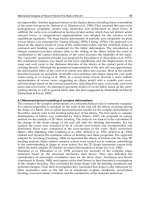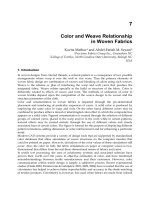Recent Advances in Wireless Communications and Networks Part 16 pot
Bạn đang xem bản rút gọn của tài liệu. Xem và tải ngay bản đầy đủ của tài liệu tại đây (878.67 KB, 16 trang )
Extending Applications of Dielectric Elastomer
Artificial Muscles to Wireless Communication Systems
439
principle devices for use in leg robots (see Fig. 4), swimming robots, snakelike robots,
compact inspection robots, geckolike robots for climbing up perpendicular walls or across
ceilings, and flying robots, as well as in achieving compatibility with living organisms are
currently developed (Stanford et. al., 2004b). The main feature of the dielectric elastomers is
that they do not use any gears and cams, thus enabling high efficiency and safe and smooth
driving even if the speed or direction of movement are suddenly changed.
Linear strain Bend Rotation
(a)
(b)
Fig. 4. Biologically inspired robots powered by dielectric elastomer rolls (Pei et al, 2003;
Chiba et al, 2006a). (a) Role Actuator Having 3-DOF (b) Application example to a robot: it
enables sideways stepping like a crab without turning around, when it collides with wall
The 3-DOF actuator may be used as actuator for variable antenna of wireless communication
device (see section 3 “Proof-of-principle experiment on a frequency-variable antenna
utilizing the actuator mode of dielectric-type artificial muscles”).
Moreover, as this actuator has a wide dynamic range (DC to several tens of kHz), its
applications to speakers and vibrational devices have been advanced (see Fig. 5) (Chiba et
al., 2007a).
This device may be suitable for vibrators and speakers of wireless communication devices.
In addition, as there is a direct proportionality between the change in the capacitance and
elongation of dielectric elastomer actuators, they can be used for pressure- and position-
sensors (see Fig. 6). It may be possible to use the sensor function of dielectric elastomers to
pick up electric waves for wireless communication devices.
Recent Advances in Wireless Communications and Networks
440
Fig. 5. Structure of speaker using dielectric elastomer (The black shaped part is dielectric
elastromer) (Chiba et al., 2007a)
Fig. 6. Linear relation between capacitance and stroke of actuator (Kornbluh et al., 2004b)
3. Proof-of-principle experiment on a frequency-variable antenna utilizing the
actuator mode of dielectric-type artificial muscles
The popularization of mobile telephones has brought wireless technology even closer to our
daily lives. In recent years, improvements in integrated technology of electronic circuits and
the increasing multi-functionality of mobile terminals have led to the inclusion of a
multitude of diverse formats such as 3GPP, wireless LAN, Bluetooth, digital TV, etc., in
single mobile communication devices. Since these communication formats all use different
frequencies, it is necessary either to install a separate antenna for each wavelength, or use
one antenna that can accommodate multiple frequencies.
Extending Applications of Dielectric Elastomer
Artificial Muscles to Wireless Communication Systems
441
Methods to create an antenna that is compatible for multiple frequencies include integrating
antenna elements that can respond to multiple frequencies, and using an antenna that is
shaped so that it can tune to a broad range of frequencies. The easiest method is to change
the length of the antenna element, but because this changes the length of the antenna device,
it requires equipment such as motors and gears. This makes it difficult to use as a small,
lightweight frequency-variable antenna.
One way to resolve these problems may be to create a lightweight frequency-variable
antenna with a simple structure by utilizing dielectric-type artificial muscles in the actuator
part of a variable antenna.It may be possible to change the position of the reflection element
and/or changing the length of dipolar- or monopolar antenna elements. Furthermore, by
forming this structure onto polymers, it is possible to create a changeable-type planar
antenna that can be installed in small, lightweight portable devices.
The present experiment corroborated the possibility of creating such variable-type antennas
by using artificial muscle to change the length and tuning frequency of a monopolar
antenna.
The variable-type monopolar antenna used in this experiment had a very simple structure. It
was composed of a radial section that was attached to the dielectric artificial muscle
actuator, and an antenna element section that was installed vertically on the core. (see
Photo 2)
Photo 2. A frequency-variable antenna utilizing the actuator mode of dielectric elastomer
artificial muscles
By changing the control voltage that was applied to the artificial muscle, a structure was
created in which it was possible to change both the length of the antenna element part that
was thrust out from the radial section and the tuning frequency.
In actuators that use dielectric artificial muscles, a thin (0.05 mm) elastomer film was
attached to a 10 cm-diameter circular frame. By attaching two of these elastomers onto this
frame, it became a diaphragm type with the cores of the elastomers attached to one another.
The total weight, including the structural parts, was about 20 g.
The frequencies used in the experiment were in the 2.45 GHz band that is currently used in
3GPP, wireless LAN, and so on. The length L of the monopolar antenna element at a
frequency of 2.45 GHz was 1/4 of the wavelength λ (122.4 mm), or 122.4/4 = 30.6 mm, and
Recent Advances in Wireless Communications and Networks
442
the changeable width of the actuator was 4 mm. This made it possible to change the tuning
frequency within a range of about 300 MHz.
The change in the tuning frequency was confirmed by measuring V. S. W. R. (Voltage
Standing Wave Ratio) using a network analyzer (Photo 3).
(a) Before change (b) At the time of the maximum change
Photo 3. Measurement of V. S. W. R. (The setting frequency range of a network analyzer:
start frequency, 1.8 GHz and stop frequency, 2.9 GHz)
In this experiment, a diaphragm actuator for artificial muscle speakers was used, but this
system was not smart, because the muscle part was too large. However, since the purpose of
this experiment was to make the resonant frequency of a non-directional antenna variable
by changing the length of the antenna element, a monopole antenna, which has the simplest
structure, and artificial diaphragm muscles were used.
In our next experiment, we plan to change the direction of electric wave radiation by
varying the installation angle of a directional antenna with roll-type artificial muscles.
In another words, the plan call for conducting an experiment to vary the directivity inside
the vertical face of the antenna by making a model (ground plane) antenna by changing the
wire in the radial part, and enabling the angle of attachment to the radial part to be changed
by the roll-type artificial muscle. If such a variable antenna can be put to practical use, then
it might be possible to create a system where the antenna can automatically be varied to
match a more optimal electric wave environment, and even a small amount of electric
power can be used to construct a suitable electric wave environment.
Furthermore, plans are being drawn for conducting an experiment on a planar antenna
whose directivity and tuning frequency can be changed by using the dielectric-type artificial
muscle to transform the antenna formed on the polymer. In the near future, by using
variable antennas whose shape changes to match the use in mobile telephones, personal
computers, etc., it may be possible to create a pleasant wireless communications
environment with just a little bit of electrical power.
4. Sensor network that utilizes the power generation mode of a dielectric
elastomer artificial muscle
Another working mode of the dielectric elastomer artificial muscle is the power generation
mode. This is operatively the opposite of the actuator function. By adding external power to
the dielectric type artificial muscle, the shape can be changed, and the increased static
Extending Applications of Dielectric Elastomer
Artificial Muscles to Wireless Communication Systems
443
electrical energy produced therefrom can generate electricity. Since this power generation
phenomenon is not dependent on the speed of transformation, its power generation device
can generate electric energy by utilizing natural energies such as up-and-down motions of
waves, slowly flowing river water, human and animal movements, and vibration energies
produced from vehicles and buildings.
4.1 Principal of the power generation mode
The operation principle in the generator mode is the transformation of mechanical energy
into electric energy by deformation of the dielectric elastomer (Ashida et al,:2000b).
Functionally, this mode resembles piezoelectricity, but its power generation mechanism is
fundamentally different. With dielectric elastomer, electric power can be generated even by
a slow change in the shape of dielectric elastomer, while for piezoelectric devices impulsive
mechanical forces are needed to generate the electric power. Also, the amount of electric
energy generated and conversion efficiency from mechanical to electrical energy can be
greater than that from piezoelectricity (Chiba et al,. 2007a).
Fig.7 shows the operating
principal of dielectric elastomer power generation.
Fig. 7. Operating principle of dielectric elastomer power generation
Application of mechanical energy to dielectric elastomer to stretch it causes compression in
thickness and expansion of the surface area. At this moment, electrostatic energy is
produced and stored on the polymer as electric charge. When the mechanical energy
decreases, the recovery force of the dielectric elastomer acts to restore the original thickness
and to decrease the in-plane area. At this time, the electric charge is pushed out to the
electrode direction. This change in electric charge increases the voltage difference, resulting
in an increase of electrostatic energy.
C =ε
0
εA/t =ε
0
εb/t
2
(1)
where ε
0
is the dielectric permittivity of free space, ε is the dielectric constant of the polymer
film, A is the active polymer area, and t
and b are the thickness and the volume of the
polymer. The second equality in Equation (1) can be written because the volume of
elastomer is essentially constant, i.e., At = b = constant.
The energy output of a dielectric elastomer generator per cycle of stretching and contraction
is
E = 0.5C
1
V
b
2
(C
1
/C
2
-1) (2)
Recent Advances in Wireless Communications and Networks
444
where C
1
and C
2
are the total capacitances of the dielectric elastomer films in the stretched
and contracted states, respectively, and V
b
is the bias voltage.
Considering then changes with respect to voltages, the electric charge Q on a dielectric
elastomer film can be considered to be constant over a short period of time and in the basic
circuit. Since V = Q/C, the voltages in the stretched state and the contracted state can be
expressed as V
1
and V
2
, respectively, and the following equation is obtained:
V
2
= Q/C
2
= (C
1
/C
2
) (Q/C
1
) = (C
1
/C
2
) V
1
(3)
Since C
2
< C
1
, the contracted voltage is higher than the stretched voltage, corresponding to
the energy argument noted above. The higher voltage can be measured and compared with
predictions based on the dielectric elastomer theory. In general, experimental data based on
high impedance measurements are in excellent agreement with predictions. When the
conductivity is assumed to be preserved in the range of electric charging, Q remains
constant.
(a)
(b)
Fig. 8. Voltage for compression of dielectric elastomer and measurement circuit. (a) Typical
scope trace from contraction of dielectric elastomer. Voltage spike occurs at contraction and
gradually back to (stretched) voltage due to load resistance. (b) Measurement circuit of
generated energy
Extending Applications of Dielectric Elastomer
Artificial Muscles to Wireless Communication Systems
445
Figure 8(a) shows a typical scope trace from contraction of dielectric elastomer. Figure 8(b)
shows a simplified circuit for oscilloscope measurement of voltage. The voltage peak
generated for one cycle is typically on the order of a few ms to several tens of ms for a
piezoelectric element. However, in the case of dielectric elastomer, the peak width is on the
order of 150-200 ms or longer (Chiba et al., 2008a). The long power-generation pulse
duration of dielectric elastomer can allow for the direct use of generated energy for activities
such as lighting LEDs. This can even power wireless equipment that is evolving today at a
rapid pace. In continuous cyclical motions, it is easy to continuously obtain electrical energy
by using flat and smooth circuits, even with gentle kinetic energy below a few Hz (Chiba et
al., 2007b)
4.2 Application of dielectric elastomer generator to wireless communication system
In a power generation experiment, a thin artificial muscle film (25 cm long x 5cm wide,
weight about 0.5 g) attached a human arm was able to generate 20 mJ of electrical energy
with one arm movement. It is also possible to make them generate electricity putting up
dielectric elastomers besides the arm to the side and the chest of the body (See Fig. 9a).
(a)
Streched state Relaxed states
(b)
Fig. 9. Harvesting energy system from human body. (a) Conceptual rendering of dielectric
elastomers put up to side and chest of arm and body: (b) Stretched state of dielectric
elastomer (left) and Relaxed state of the elastomer (right)
Recent Advances in Wireless Communications and Networks
446
Furthermore, in an experiment using different power generation equipment, artificial muscle
film attached to the bottom of a shoe was verified to generate electricity when the artificial
muscle was distorted while walking. When an adult male took one step per second, one
shoe was able to produce about 1 W of electrical power. (Harsha et al., 2005)
Fig. 10. Shoe generator
This confirmed that by utilizing human movement, enough electrical power could be
obtained to recharge batteries for mobile telephones and similar devices (Chiba et al., 2008).
In addition, electrical energy from the movements of animals could be used to construct
livestock management systems. Other applications of animal-generated energy being
investigated include scientific surveys of ecosystems of migratory birds and fish, among
others.
In an experiment using a diaphragm actuator, electrical power output of about 0.12 – 0.15W
was obtained by pressing the center of a roughly 1 g, 8 cm-diameter EPAM a few
millimeters one time per second (Chiba et al., 2007a). Using the same equipment, the electric
power generated was able to illuminate 6 LEDs, and by combining this with a wireless
system, it became possible to turn a device on and off from a remote location.
In such ways, dielectric elastomer artificial muscles can supply electrical power only when
mechanical energy is obtained, and it is possible to simultaneously act as a switch that
detects power sources and motion. Consequently, it may possible to easily create wireless
networks, with simple components that do not require batteries (Chiba et al., 2007a).
In recent years, global warming and accompanying abnormal weather have begun to have
an impact on our daily lives. To protect ourselves from the disasters brought about by
abnormal weather, it is important to thoroughly understand the current situation, that is,
how the global environment is changing.
The monitoring of the global environment has been done by various countries on their own,
but to monitor environmental changes on a global scale it will be necessary to build wide-
ranging sensor networks. One of the major issues with that, however, is that there is no
good method for obtaining electrical energy for running this system. Presently, many if not
most of these sensor systems are powered by solar batteries, but in some locations and
during some seasons the daylight hours are extremely short, and in maritime and desert
Extending Applications of Dielectric Elastomer
Artificial Muscles to Wireless Communication Systems
447
areas salt and dust can dramatically reduce the electrical output. All this makes it difficult to
maintain a stable sensor system.
(a)
(b)
Photo 4. Small scale power generation device. a) Cartridge of used for small generator.
The black ring-shaped part is dielectric elastomer. b) A power of approximately 0.12 W can
be generated, by pushing the central part of dielectric elastomer by 3- 4 mm once a second
As one way of resolving these issues, power generation systems that utilize artificial
muscles to generate power through transformation alone are attracting attention. Already,
experiments using wave power to generate electricity have been able to produce a few watts
of electrical energy with small artificial muscle power generation equipment loaded onto
Recent Advances in Wireless Communications and Networks
448
weather observation buoys, (see photo 6 and fig. 11) and this has also been confirmed to
recharge batteries (Chiba et al., 2009).
Photo 5. Small scale power generation device & LED controlled by wireless signals
Photo 6. Dielectric elastomer generator on the test buoy
Extending Applications of Dielectric Elastomer
Artificial Muscles to Wireless Communication Systems
449
Fig. 11. Electricity generated by ten centimeter-high waves
In other experiments (see photo 7), electrical energy has been obtained from flowing water
in a laboratory (Chiba et al., 2007a). The flow of water rotates the water-mill, and the
rotational motion induces the deformation of the dielectric elastomer to generate electrical
energy. Figure 12 shows the conceptual rendering of water mill generator using dielectric
elastomer (Chiba et al., 2007a).
Furthermore, the results of simulations based on conceptual designs of flag-type power
generation equipment using artificial muscles have indicated that there is little loss from the
fluttering of flags and that it is possible to generate electric power with a high rate of
efficiency (Chiba et al., 2007b).
Photo 7. Water mill generator using dielectric elastomer
Recent Advances in Wireless Communications and Networks
450
Fig. 12. Conceptual rendering of water mill generator using dielectric elastomer (Chiba et al.,
2010)
Fig. 13. Conceptual rendering of flag-type power generation
4.3 Analysis of power generation cost
Even without dielectric elastomer technology, ocean wave power is beginning to flourish in
several countries. These ocean wave power systems typically use hydraulic pistons that are
pumped by the wave action. The hydraulic fluid flows through a transmission and then a
turbine to spin a rotary electromagnetic generator. When these systems are successfully
developed for commercial use, the unit price of a power generation of kWh is estimated to
be about 20 US Cents (Chiba et al., 2008b). These wave power systems are typically designed
for ocean waves exceeding 2 - 3 m in height. At significantly smaller wave heights, the
systems become less economically attractive (Miyazaki et al, 2007).
Extending Applications of Dielectric Elastomer
Artificial Muscles to Wireless Communication Systems
451
Fig. 14. Conceptual rendering of wave power generator system using dielectric elastomers
Because of its simplicity, efficiency, and size scalability, we believe that dielectric elastomer-
based wave generator systems can be attractive not only for large wave applications but for
many applications where the waves are much smaller. An estimate based on data from our
sea trial demonstration experiments has shown that even in seas where the wave height is
only 1 m throughout the year (e.g., the sea close to Japan), if there are spaces of
approximately 500 m in length and 10 m in width, the establishment of a sea-based facility
generating 6 MW of power is possible (Chiba et al., 2008b). This is a useful amount of
power, be it for general use or for providing energy for nearby residential or industrial
needs. The ability to produce the power where it is needed can eliminate the losses and costs
associated with power transmission over long distances and make wave power even more
attractive. The power generation efficiency estimated on the basis of the data obtained from
in-tank experiments in 2006 (Chiba et al, 2006b) and ocean demonstration experiments in
2007 (Chiba et al, 2008a) and 2008 (Chiba et al, 2009) is approximately 19 US cents/kWh. In
the near future, we expect that the electric power generation per unit mass or volume of
dielectric elastomer material can double, and that the expected power generation cost per
Recent Advances in Wireless Communications and Networks
452
kilowatt-hour is 5 - 7.5 US cents.
This value is comparable to that for fossil fuel thermal
power plants. Of course, the wave power systems have the additional benefit of not
releasing any pollution or greenhouse gasses.
5. Future of dielectric elastomer systems to wireless communication
The variable antenna technologies with artificial muscles have high expectations to apply to
not only data communications for mobile phones and personal computers but also wireless
sensor systems which monitor various data concerning weather conditions and environments.
In the future, the combination of these artificial muscle power-generating systems with
various sensing systems will make it possible to conduct sensing on a global scale, and may
even make a significant contribution to the creation of systems that will protect human lives
from natural disasters that have so far been difficult to predict.
Various power generating systems can be set up in each place on the earth as shown in
Figure 15 in order to create wire sensor networks.
Fig. 15. Sites where power generation using dielectric elastomers is possible and conceptual
rendering of the generation systems: (a) Wind Power Generator on tops of buildings (Chiba
et al., 2007b) (b) Water Mill Generators (Chiba et al., 2007a) (c) Waste energy Generators
(Chiba et al., 2011) (d) Drain Generators (Chiba et al., 2011) (e) Wind Power Generators for
Personal Houses (f) Solar Heat Generators (Chiba et al., 2007b) (g) Wave Generators (Chiba
et al., 2006; Chiba et al., 2008a) (h) Wave Generators in Ocean (Chiba et al., 2008a) (i) Hydrogen
Production Plant (Chiba et al., 2008b)
6. References
Chiba S., et al. (2007a). Extending Applications of Dielectric Elastomer Artificial Muscle.
Proceedings of SPIE, San Diego, March 2007.
Extending Applications of Dielectric Elastomer
Artificial Muscles to Wireless Communication Systems
453
Chiba S.; Stanford S., Pelrine R., Kornbluh R., and Prahlad H. (2006a), Electroactive Polymer
Artificial Muscle, JRSJ, Vol. 24, No.4, pp 38-42. 2006.
Chiba S,; Prahad H, Pelrine R, Konbluh R, Stanford S and Eckerle J. (2006b). Electro Power
Generation Using Electro active Polymers (EPAM). Proceedings of 15
th
Japan
Institute of Energy Conference (Kogakuuin University, Japan) JIE pp 297-298, July
2006.
Chiba S.; Pelrine R., Kornbluh R., Prahlad H., Stanford S., & Eckerle J. (2007b). New
Opportunities in Electric Generation Using Electroactive Polymer Artificial Muscle
(EPAM). J. Japan. Inst. Energy, Vol. 86, No. 9, pp. 38-42, 2007.
Chiba S (2002), Dielectric Elastomer for MEMS and NEMS and Toward the Future. Electro
Packing Technology, Vol.18, No. 1, pp 33-38, 2002.
Chiba S.; Waki M., Kormbluh R., & Pelrine R. (2008a). Innovative Power Generators for
Energy Harvesting Using Electroactive Polymer Artificial Muscles, Electroactive
Polymer Actuators and Devices (EAPAD), ed. Y. Bar-Cohen. Proceedings of SPIE.
Vol. 6927, 692715 (1-9), San Diego, March 2008.
Chiba, S., Kornbluh R., Pelrine R., and Waki M. (2008b) “Low-cost Hydrogen Production
From Electroactive Polymer Artificial Muscle Wave Power Generators”, Proceedings
of World Hydrogen Energy Conference, Brisbane, Australia, June 16-20, 2008.
Chiba, S., Waki M., Kornbluh K., and Pelrine R (2009). Innovative Wave Power Generation
System Using EPAM. Proceedings of Oceans’ 09, Bremen, Germany, May 2009.
Chiba S. and Waki M. (2011). Recent Progress in Dielectric Elastomers (Harvesting Energy
Mode and High Efficient Actuation Mode), To be published in Clean Tech, Nihon
Kogyo Shuppan, Tokyo, Japan, April, 2011.
Harsha P, Kornbluh R, Pelrine R, Stanford S, Eckerle J and Oh S. (2005). Polymer Power:
Dielectric elastomers and their applications in distributed actuation and power
generation. Proceedings of ISSS 2005, International Conference on Smart Materials
Structures and Systems. Bangalore, India.
Kornbluh R., Pelrine R., and Chiba S. (2004b). Silicon to Siliocon: Stretching the Capabilities
of Micromachines with Electroactive polymers, IEEJ, Vol.124, No. 8, 2004, ISSN
1341-8939.
Miyazaki T and Osawa H. (2007). Search Report of Wave Power Devices Proceedings of
Spring Conference of the Japan Socity of Naval Architects and Ocean Engineers, No.4
pp43-46, April 2007.
Pelrine R., and Chiba S. (1992a). Review of Artificial Muscle Approaches. Proceedings of
Third International Symposium on Micromachine and Human Science, Nagoya, Japan,
June 1992.
Pelrine R.; Kornbluh K., Pei Q., & Joseph J. (2000a). High Speed Electrically Actuated
Elastomers with Over 100% Strain. Science 287: 5454, pp 836–839, 2000.
Pei Q., Rosenthal M., Pelrine R., Stanford S., and Kornbluh R (2003) Multifunctional
electroelastmer roll actuators and their application for biomimetic walking robots,
proceedings of SPIE, Smart Structures and mterials, Electroactive Polymer
Actuators and Devices (EAPAD), ed. Y. Bar-Cohen, San Diego, CA, March 2003.
Stanford S, Bonwit N, Pelrine R, Kornbluh R, Pei Q and Chiba S (2004b). Electro Polymer
Artificial Muscle (EPAM) for Biomimetics Robots. Proceedings of 2
nd
Conference on
Artificial Muscles. AIST Kansai Center, Osaka, Japan, 2004.
Recent Advances in Wireless Communications and Networks
454
Oguro K., Fujiwara N., Asaka K., Onishi K. and Sewa S. (1999). Polymer electrolyte actuator
with gold electrodes. Proceedings of the SPIE’s 6
th
Annual International Symposium on
Smart Structures and Materials, SPIE Proc. Vol. 3669,(1999), pp. 64-71.
Otero F. and Sansiñena M. (1998). Soft and wet conducting polymers for artificial muscles”,
Advanced Materials, 10 (6), (1998) pp. 491-494.
Osada Y., Okuzaki H. and Hori H. (1992b). A polymer gel with electrically driven motility”,
Nature, Vol. 355, pp. 242-244, (1992).
Ashida A., Ichiki M., Tanaka T. and Kitahara T. (2000b). Power Generation Using Piezo
Element: Energy Conversion Efficiency of Piezo Element”, Proc. of JAME annual
meeting, pp.139-140, (2000).









